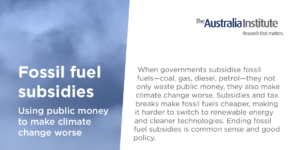Originally published in the Australian Financial Review – here.
The differences between rugby league and rugby union, like the differences between the disciplines of economics and finance, can seem obscure to those who aren’t fans of either. Subtle though they may be, small differences can have big impacts on the end result. Indeed, those small differences help explain why, despite the record-low coal price, there are 50 new coal mines being proposed in Australia.
While the pledges and promises made in Paris over the weekend provide yet another reason to be downbeat about coal demand and prices, Adani, the Indian mining company, is so eager to get started on their enormous new Carmichael coal mine that they are pressuring the Prime Minister to speed its approval up. Such plans make no financial sense. Economics can partly explain what’s going on, and politics can explain the rest.
Financial analysts try to help rational investors evaluate investment options in order to maximise returns. As a rule, financial analysts pay more attention to data than theory, and, in turn usually do a better job than economists when it comes to modelling the likely performance of specific projects or companies.
Last week the analysts at Wood Mackenzie suggested two-thirds of coal mines are losing money at current coal prices. I’ll trust the finance guys on that. But Economics 101 tells us that firms might keep digging even when they are losing money in order to ‘loss minimise’. But that still doesn’t explain why anyone would want to build a new coal mine rather than buy a broke one.
Economists, for all of our faults, typically look for broader links between actions and reactions than our friends in finance. Imprecise though it may be, economic theory can help us anticipate what others call ‘unintended consequences’. The economic theory of the ‘green paradox’, for example, helps explain why in a sinking coal market there are a flood of new coal mines being proposed.
SELL IT BEFORE IT MELTS
Imagine you owned an ice cream van parked by the beach and your refrigerator broke. No matter what you paid for the ice cream you should sell it for anything you can before it melts. Some money is better than no money.
Now imagine that you owned billions of tonnes of coal and you thought that in 20 years time new technology or new global restrictions meant you might not be able to sell it. We have heard for decades how Australia had ‘hundreds of years’ worth of coal, but now we are trying to sell it in a few decades. The green paradox says that talk of future emission reductions can cause an increase in current coal production. Indeed, global coal production has risen 50 percent since the world first agreed to reduce emissions in 1992.
One thing economists and finance analysts can agree on is that betting billions on new coal mines is a risky thing to do in this climate. Which is where politics comes in. The mining industry has a knack for getting governments to subsidise the upfront costs of building mines by simply calling their construction costs ‘infrastructure’. For example, both the former Queensland government and the current federal government made offers to help fund Adani’s mine construction costs. Indeed, Joe Hockey wanted to “ensure the [Adani] railway line remains financially viable”. Who knew that was a job for a Commonwealth Treasurer.
At the same time that scientists, economists and other countries are calling for deep cuts to greenhouse gas emissions and a global moratorium on building new coal mines, Australia is planning to double our coal export capacity. Someone is going to lose. While the coal boosters in Australia are urging the Australian taxpayer to fund the ‘infrastructure investment’ the coal industry needs, the real question is what kind of investment does the Australia of 2050 need.
While the financial modelling suggests that building new coal mines make no sense, economic theory provides some explanation of why coal supply is increasing even as the coal price is falling. That said, only politics can explain why taxpayers funds would be used to drive up the supply of the same commodity that world leaders in Paris just agreed to buy a lot less of in the coming decades.
Richard Denniss is the chief economist at The Australia Institute. @RDNS_TAI
AFR Contributor
Related documents
Between the Lines Newsletter
The biggest stories and the best analysis from the team at the Australia Institute, delivered to your inbox every fortnight.
You might also like
Should Australia ban fossil fuel advertising?
A tobacco-style ban on fossil fuel advertising would be a decisive win for Australia – and the climate.
Fossil fuel subsidies
When governments subsidise fossil fuels—coal, gas, diesel, petrol—they not only waste public money, they also make climate change worse. Subsidies and tax breaks make fossil fuels cheaper, making it harder to switch to renewable energy and cleaner technologies. Ending fossil fuel subsidies is common sense and good policy.
Extreme heat fans flames of inequality
New research from The Australia Institute shows that older, sicker and lower-income Australians are at greater risk during heatwaves (days over 35° Celsius).



